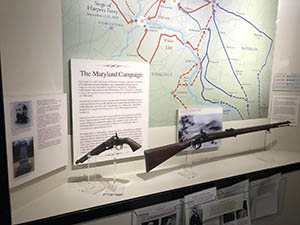Washington Monument History
 Washington Monument is constructed
Washington Monument is constructed
On July 4, 1827, nearly the entire village of Boonsboro trekked up South Mountain to build and dedicate the Washington Monument—the first completed monument in the United States to memorialize General and President George Washington. The town’s citizens erected half the monument that day using granite found onsite. Then, at 4 p.m., they held a brief dedication ceremony where they read the Declaration of Independence aloud, and four Revolutionary War veterans fired a ceremonial volley. The Boonsboro residents returned on a second day in September to finish it. Upon completion, the monument stood 30 feet high, and had a 54 foot circumference at the base.
A detailed account of the construction of Washington Monument is found in the July 12, 1827 issue of the Hagerstown Torchlight. The article describes the monument:
“As it was raised in much haste, we cannot boast the regular accuracy of perfect beauty, yet it possesses both solidity and durability, two important qualities—It has such strength as I think will preserve it for ages. Though rude and naked of all charms of architecture, yet there is an ever-blooming spirit diffused even through the dry walls of such fabricks, as fully supplies the want of elegance. We do no calculate that when finished, it will give this town immortal glory, but we do sincerely hope it will be the means of stirring up the fading gratitude of the people….”
 Washington Monument during the Civil War
Washington Monument during the Civil War
During the Civil War the monument was used on several occasions as the location of a signal station. The signal system used flags to make left and right swinging motions which read as a “1” or a “2.” The combinations of 1’s and 2’s would translate into letters and phrases once deciphered. The “Wig Wag” system would get its nickname because to the untrained eye, the flag movements looked like uncoordinated movements. Besides flags, signalmen also used signal pistols and rockets that produced different colored smoke when fired.
 The Monument after the Civil War
The Monument after the Civil War
After decades of neglect, the Washington Monument was restored to its former glory in 1882 by Boonsboro’s South Mountain Encampment No. 25 of the Independent Order of Odd Fellows. The restoration was financed by both the Odd Fellows, and through a public donation drive. However, after a brief revival, the monument again fell victim to neglect and vandalism. The monument was damaged by dynamite at least once, and in May of 1916, the Hagerstown Daily Mail reported that the monument had been vandalized by “mountaineers.” It is this incident that most likely reduced the monument to half its original size.
Restoration of the Monument and Development of a State Park
The Washington Monument was restored during one of the nation’s worst economic crises—the Great Depression. In 1934, the Washington County Historical Society deeded the monument to the Maryland State Department of Forestry. Shortly thereafter, the Civilian Conservation Corps (CCC) rebuilt the monument. After nearly a year-and-a-half of labor, the Washington Monument was rededicated in a grand ceremony on July 4, 1936.
Museum
The Washington Monument museum contains displays and artifacts about the history of the monument. Exhibits also include a summary of the 1862 Maryland Campaign and a fiber-optic map presenting an overview of the Battle of South Mountain. The museum is open in the spring, summer, and fall.